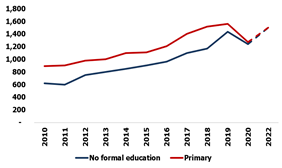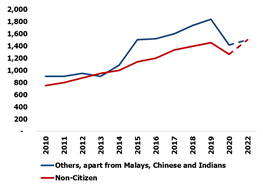Effective May 1, the statutory minimum wage will be increased from RM1,200 to RM1,500. The impending hike is expected as the Minimum Wages Order goes through a review every two years. However, the quantum of the hike in percentage and value terms – at 25% and RM300 – is unprecedented. Furthermore, the hike comes at a time when the Malaysian economy has yet to fully recover from its worst economic crisis since the 1997 Asian Financial Crisis.
The minimum wage has, without a doubt, benefited Malaysia's low-wage earners. According to a United Nations Economic and Social Commission for Asia and the Pacific (ESCAP) report titled Closing the Gap, the average income of Malaysia's B40 group more than tripled between 2009 and 2015, thanks in part to the country's 2012 minimum wage legislation.
We believe that a higher minimum wage is warranted for several reasons. Firstly, it revitalises the overall wage growth which has lost steam amid the pandemic. Secondly, a higher minimum wage benefits Malaysian workers with low or no formal education, workers in the East Coast states of the Peninsular, female workers, lowly paid occupations and industries (e.g., service and sales, rural sectors, elementary occupations, and support service activities), and ethnic minorities. And thirdly, the pay gap between Malaysian and non-citizen workers, urban-rural, education attainment, and gender will narrow significantly. Essentially, the new minimum wage level would support the wage-to-GDP ratio higher towards the 12th Malaysia Plan target of 40% by 2025 (2020: 37.5%).
Having said that, we are concerned about the exemptions under the Minimum Wages Order 2022 and the grace period given to micro, small and medium enterprises (MSMEs). The exclusions would blunt the favourable wage growth impact in the sectors and industries mentioned above and subsequently diminish the very objective of imposing a minimum wage level, i.e., to protect workers against unduly low pay in the lowest income bracket. In essence, exclusions mean that the statutory minimum wage level is higher than what it is in practice.
We believe that the minimum wage level should be, as the name suggests, set at the lowest pay level across economic sectors, workers and regions. We also think it is better to focus the minimum wage rate based on an hourly basis, rather than monthly.
The minimum wage should not be used as a policy tool to substitute for policy efforts aimed at promoting wage-enhancing real economic activities. In other words, infrastructure investments and economic liberalisation should eventually bridge pay gaps between employment sectors, as well as economic disparities between geographical regions.
In the final analysis, getting the minimum wage level right is paramount because, among other things, it can only go up, and never down. It is important to note that wage growth through legislative means is unsustainable and may even impede structural wage growth.
| Chart 1: Median wages of employees by age groups (RM), 2010 - 2020 | Chart 2: Median wages of employees by education attainments (RM), 2010 - 2020 | ||
 |
 |
||
| Sources: Department of Statistics Malaysia (DOSM), MARC Ratings | Sources: DOSM, MARC Ratings | ||
| Chart 3: Median wages of employees by states (RM), 2010 - 2020 | Chart 4: Median wages of female employees by states, (RM), 2010 - 2020 | ||
 |
 |
||
| Sources: DOSM, MARC Ratings | Sources: DOSM, MARC Ratings | ||
| Chart 5: Median wages of employees by occupations (RM), 2010 - 2020 | Chart 6: Median wages of employees by industries (RM), 2010 - 2020 | ||
 |
 |
||
| Sources: DOSM, MARC Ratings | Sources: DOSM, MARC Ratings | ||
| Chart 7: Median wages of employees by ethnicities (RM), 2010 - 2020 | Chart 8: Median wages of non- citizen employees by strata and gender (RM), 2010 - 2020 | ||
 |
 |
||
| Sources: DOSM, MARC Ratings | Sources: DOSM, MARC Ratings |
Contact:
Firdaos Rosli, +603-2717 2936/ firdaos@marc.com.my








